If you’re looking for an easy way to stream music wirelessly from your phone or computer to your home stereo system, a wifi audio receiver adapter might be just what you need. This simple device connects to your stereo through an AUX or RCA input and allows you to stream high-quality audio over your home wifi network.
Before buying a wifi audio receiver adapter, there are a few factors to consider. First, make sure your home wifi network is strong enough to handle the streaming. If you have a weak signal or slow internet speed, you may experience interruptions or buffering. It’s also important to ensure your stereo system has the necessary inputs to connect the adapter. Finally, consider the range of the adapter – if you need to stream from a room far away from your wifi router, a long-range adapter may be necessary.
What sets wifi audio receiver adapters apart from other streaming devices is their versatility. You can use them to stream music from popular services like Spotify or Pandora, or play your own music files from your phone or computer. Some adapters even come with a built-in microphone, allowing you to take hands-free calls through your stereo system. Plus, they’re incredibly easy to set up – simply plug in, connect to your wifi network, and start streaming.
Are you tired of having to physically plug your phone into your stereo system every time you want to listen to music? Do you want a wireless way to take calls through your home speakers? If so, a wifi audio receiver adapter might be the perfect solution for you. Keep reading to learn more about the benefits of this simple device, and find out which adapter is right for your home.
10 Best Wifi Audio Receiver Adapter
| # | Product Image | Product Name | Product Notes | Check Price |
|---|---|---|---|---|
|
1
|
Ideal for streaming high-quality audio from multiple sources wirelessly, with support for Siri, WiFi, Bluetooth, and multiroom/multizone setups.
|
|
||
|
2
|
The product is ideal for streaming music wirelessly with low-latency to speakers, amps, and other audio devices via Wi-Fi.
|
|
||
|
3
|
The product is ideal for adding wireless audio connectivity to any stereo system with RCA or 3.5mm inputs.
|
|
||
|
4
|
The product is ideal for streaming music wirelessly from Apple devices to speakers, amplifiers, and home stereos with dual ports.
|
|
||
|
5
|
The product is ideal for streaming audio from mobile devices or NAS to speaker systems over a Wi-Fi network.
|
|
||
|
6
|
Ideal for streaming audio wirelessly from various devices to home stereo, AV receiver, or amplifier with high-resolution audio quality.
|
|
||
|
7
|
The product is ideal for streaming high-quality music throughout your home from various services such as Spotify and Tidal.
|
|
||
|
8
|
The product is ideal for streaming high-quality audio from popular music services and controlling it with virtual voice assistants.
|
|
||
|
9
|
The product is ideal for converting wired speaker systems into wireless by providing WiFi, Bluetooth, and remote control compatibility.
|
|
||
|
10
|
This product is ideal for making any speaker wireless and connecting it through WiFi or Ethernet for AirPlay and Spotify Connect compatibility.
|
|
1. Olioair – Hi-Res Wifi Audio Receiver
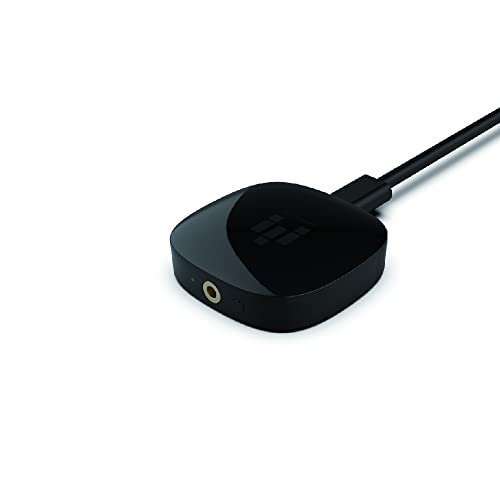
Experience the convenience of controlling your music with your voice using the IEAST Oliostreamer 1, which is compatible with Amazon Alexa and Siri devices. With just a few spoken commands, you can easily control your music playback.
Stream your music throughout your home with the IEAST Oliostreamer 1 via Airplay 2, Amazon Alexa or the iEAST App multi-room functions. You can effortlessly stream music to multiple audio devices at the same time.
Enjoy multi-room streaming with the IEAST Olio, which offers three different methods for you to use. You can use Airplay 2 if you mainly use APL products, Alexa Multi-room if you have Amazon devices, or the iEAST APP's multi-room function.
Stream music directly from any software that supports Spotify Connect or Tidal Connect, without using the iEAST app. Additionally, you can easily access popular online music services such as Tuneln, Amazon Music, SiriusXM, Deezer, Qobuz, Internet Radio, Pandra, iHeart Radio, Napster, and many more through the iEAST App.
Fill your home with brilliant sound using the IEAST Olio, which is one of the few devices in the market capable of streaming Hi-Res 192Khz/24bit CD Quality music wirelessly. This cost-effective device allows you to add wireless capability and multi-room streaming functions to your home audio system, making it a fantastic addition to your home entertainment setup.
- Compatible with Amazon Alexa and Siri for easy voice control.
- Effortlessly stream music to multiple audio devices at the same time.
- Offers three different multi-room methods to suit your needs.
- Directly stream music from Spotify Connect or Tidal Connect without using the iEAST app.
- Access popular online music services through the iEAST app.
- Capable of streaming Hi-Res 192Khz/24bit CD Quality music wirelessly.
- Cost-effective device that adds wireless capability and multi-room streaming functions to your home audio system.
2. Audioengine Multiroom Streamer: High-Quality Wireless Music Receiver
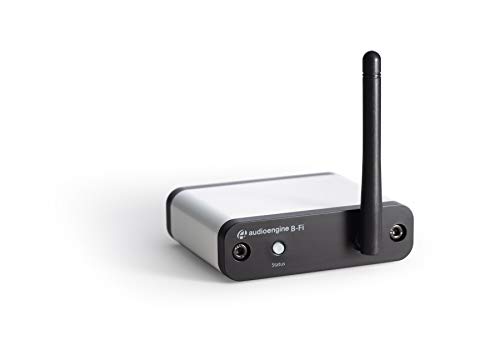
Upgrade your home stereo system with ease and enjoy wireless streaming of your favorite music services or library from your phone, tablet, or computer with the B-Fi Streamer from Audioengine. This lossless wireless streaming connectivity device is designed to breathe new life into your home music system by delivering incredible sound quality through its high-quality DAC and gold-plated RCA or Optical outputs.
With B-Fi Streamer, you can enjoy multiroom listening by adding additional streamers or Audioengine A1-MRs to create a whole-home music system with independent zones and volume control. The easy-to-use app puts full control of your music at your fingertips, allowing you to play any song from any service in any room or every room.
B-Fi Streamer supports various streaming services including Spotify, Amazon Music, Qobuz, Tidal, iHeartRadio, Napster, TuneIn, and more. You can also play your downloaded music or stream via Apple AirPlay. With B-Fi, you can enjoy your music the way it was meant to be heard.
Audioengine is committed to providing stellar US-based customer support and offers a 3-year product warranty. Based in Austin, TX, Audioengine has been changing the way people listen to music since 2005. Their passion for creating products that sound great, are easy to use, and inspire people to listen every day is reflected in the B-Fi Streamer.
- Lossless wireless streaming connectivity delivers incredible sound quality.
- Multiroom listening capabilities allow for independent zones and volume control.
- Easy-to-use app puts full control of your music at your fingertips.
- Supports various music streaming services including Spotify, Amazon Music, Qobuz, Tidal, iHeartRadio, Napster, TuneIn, and more.
- Can play downloaded music or stream via Apple AirPlay.
- Stellar US-based customer support and 3-year product warranty.
3. Svs Soundpath Tri-Band Wireless Audio Adapter
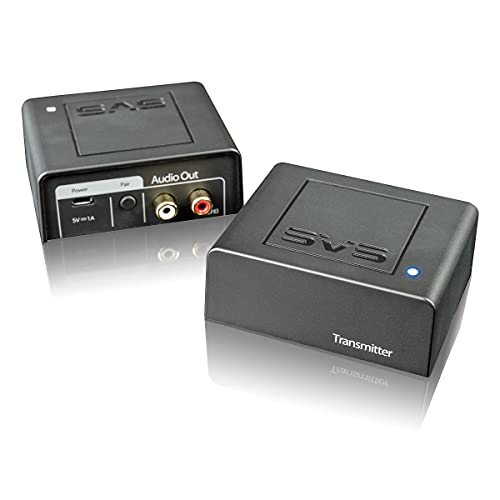
With this wireless audio transmitter, you can now enjoy pristine CD-quality (16-bit/48KHz) audio signal up to 130-feet with no noticeable delay. The left/right stereo signal transfer unlocks wireless connectivity for one or more subwoofers, 2-channel zone of powered speakers, amplifiers, powered surround speakers, and more. It streamlines your home theater system setup by removing the need for long or complicated audio cables running along floors or walls. You can now add wireless connectivity, giving you more flexibility when placing subwoofers, powered speakers, and other audio components in a room. All without sacrificing performance.
This wireless audio transmitter is the perfect solution for anyone who wants to enjoy high-quality audio without being tied down by long cables. With its impressive range and reliable performance, it is the ideal choice for home theater enthusiasts and audiophiles alike. Whether you're looking to set up a new home theater system or simply want to add wireless connectivity to your existing setup, this transmitter has everything you need to get started.
In summary, this wireless audio transmitter is a game-changer for anyone who loves high-quality audio. It offers an impressive range, reliable performance, and easy setup, making it the perfect choice for home theater enthusiasts and audiophiles alike.
- Provides pristine CD-quality (16-bit/48KHz) audio signal up to 130-feet with no noticeable delay
- Allows left/right stereo signal transfer for one or more subwoofers, 2-channel zone of powered speakers, amplifiers, powered surround speakers, and more
- Streamlines home theater system setup by removing the need for long or complicated audio cables running along floors or walls
- Adds wireless connectivity giving you more flexibility when placing subwoofers, powered speakers, and other audio components in a room
- Does not sacrifice performance
4. Wireless Multiroom Music Streamer For Iphone/ipad/macbook
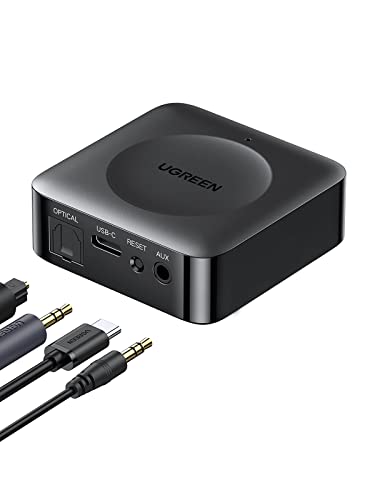
The UGREEN Airplay 2 Receiver Adapter is the perfect solution for connecting non-wireless audio equipment to Apple devices such as iPhones, iPads, iPodTouches, Macs, and Apple TVs. With Airplay2 technology, this receiver adapter enables stable and high-quality sound quality via a Wifi signal. The 48 kHz dual-band Wifi signal allows for a reliable connection of up to 40m without any delays or interruptions. Additionally, this receiver adapter can stream music to multiple rooms at home, creating a surround music experience for the whole house.
The UGREEN Airplay 2 Receiver Adapter is compatible with both 3.5mm and optical ports and can be used to connect non-wireless audio equipment such as speakers or amplifiers. However, if both 3.5mm and optical ports are connected, only the 3.5mm audio port will work by default. Furthermore, this adapter allows for independent audio source usage, meaning you can play games or make phone calls while enjoying music through Airplay2 without any interference between the two audio sources.
- Equipped with Airplay2 technology for stable and high-quality sound quality
- Allows for multi-room streaming of music to multiple rooms at home
- Compatible with Apple devices such as iPhone, iPad, iPodTouch, Mac, and Apple TV
- Can connect non-wireless audio equipment such as speakers or amplifiers through 3.5mm and optical ports
- Offers a strong ability to penetrate walls and a stable connection of up to 40m without any delays or interruptions
- Allows for independent audio source usage, enabling users to play games or make phone calls while enjoying music through Airplay2 without any interference
5. Acemax M5: Wifi Audio Streaming Made Easy
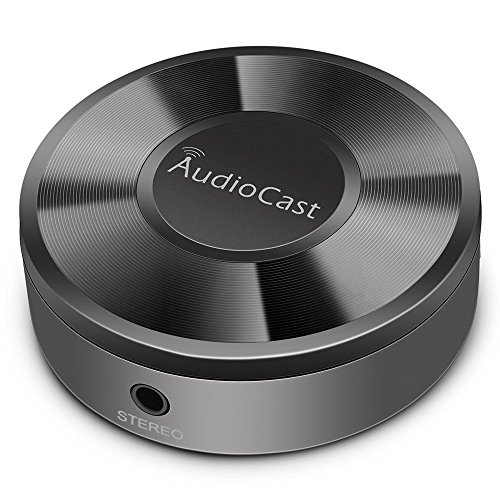
The ACEMAX M5 AudioCast is a game-changing AirPlay receiver that allows you to stream high-quality audio wirelessly from your smartphone, tablet, iPad, or PC to your non-WiFi Hi-Fi system. With this small device, you can transform your old speakers into a smart audio system with ease. It is the perfect replacement for your aging Apple Airport Express. This device supports AirPlay, DLNA, UPnP music play, and a wide range of online music services, including Amazon Music, Tuneln Radio, Spotify, DEEZER, and more. The Audiocast app also offers a vast library of free online music for searching and playing. Compatible with iPhone, iPad, Android smartphones and tablets, Mac, and Windows laptops, the ACEMAX M5 AudioCast lets you stream music synchronously to different rooms for the same or different songs. You can play your favorite music in the whole house at the same time using this feature, which is only available through the Audiocast app. Sadly, Airplay 2 is not supported.
You can control all speakers and music played on one smartphone with the AudioCast app, which allows you to stream the same song to all speakers or different music to multiple speakers. The ACEMAX M5 AudioCast provides a stronger range signal than other normal Bluetooth speaker/adapters. With this device, you can walk away a far distance as long as it is within the same Wi-Fi network. In addition, ACEMAX AudioCast offers more useful functions like music alarm, sleeping timer, and more.
- Easy to set up and use
- Compatible with a wide range of devices
- Allows you to stream music synchronously to different rooms
- Provides a stronger range signal than other normal Bluetooth speaker/adapters
- Offers more useful functions like music alarm, sleeping timer, and more
- – Airplay 2 is not supported
6. Auris Multiroom Receiver: Stream Hi-Fi Everywhere
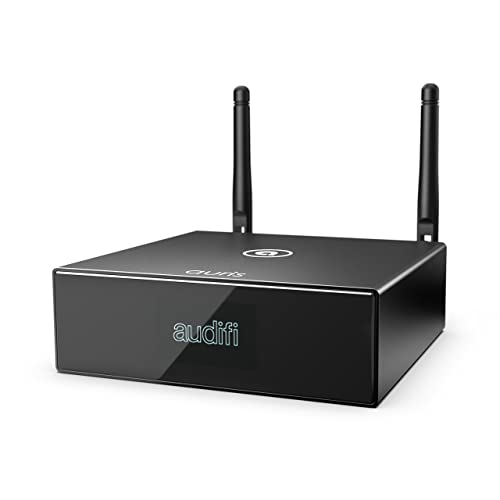
The Auris Audifi is a high-fidelity WiFi music receiver that enables you to discover a world full of music streaming services and internet radio stations, all streaming in 24-bit Hi-Res audio. It is designed to add high-quality Wi-Fi and multi-room streaming to any stereo amplifier or powered speakers, making it an ideal choice for those who want to enhance their music listening experience. You can use it as a standalone streamer with your preferred amplifier or group it with other players to create a multi-room listening experience.
Equipped with Wi-Fi and aptX HD Bluetooth connectivity, the Audifi can easily support 24-bit high-definition music streaming with flawless transmission directly from your phone or tablet. It features a built-in high-quality ESS Sabre digital-to-analogue converter (DAC) that allows it to decode and stream audio in all its lossless glory. With the Audifi, you can enjoy high-quality Hi-Res audio that will take your music listening experience to the next level.
The Audifi offers multi-room/multi-zone streaming with control app, making it easy to add additional streamers to other music systems or your home theater for multiroom sound, stereo pairing and multi-user capabilities. You can control your music from anywhere in your home through the intuitive 4Stream Control App on your phone or tablet and play any song from any service in any room or every room.
Featuring a suite of Analog RCA and Digital Coaxial/Optical input/output options and subwoofer output, the Audifi gives you infinite playback choices. With the ability to connect to your TV or CD player for audio input, the Audifi ensures that your physical music collection continues to thrive. It offers connectivity options to suit your needs and allows you to stream everything you love.
With support for Spotify Connect and Apple AirPlay, the Audifi delivers all the wireless connectivity you want, without any sonic compromises. You can stream from your music library or use in-app music services, which include Spotify, Amazon Music, TIDAL, Qobuz, iHeartRadio, TuneIn and more using your iOS or Android phone. The Audifi can be the perfect addition to your home audio system.
- High-fidelity WiFi music receiver
- Adds high-quality Wi-Fi and multi-room streaming to any stereo amplifier or powered speakers
- 24-bit Hi-Res audio streaming
- Built-in high-quality ESS Sabre digital-to-analogue converter (DAC)
- Multi-room/multi-zone streaming with control app
- Analog RCA and Digital Coaxial/Optical input/output options and subwoofer output
- Support for Spotify Connect and Apple AirPlay
- In-app music services, including Spotify, Amazon Music, TIDAL, Qobuz, iHeartRadio, TuneIn and more
- – May not be compatible with all audio systems
7. August Wr320: Your Home's Wireless Audio Upgrade.
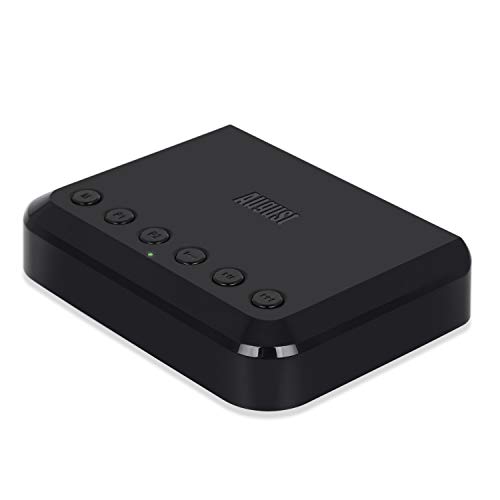
Experience crystal clear, lossless sound throughout your home with the August WR320 Wi-Fi Multiroom Stereo System. This advanced system allows you to control individual or combined playlists and streaming services for multiple speakers from the iPhone or Android App. You can enjoy your music via WiFi or Bluetooth and access supported streaming services such as Spotify, Tidal, TuneInRadio, and iHeartRadio via WiFi. Please note that this system does not support Pandora, YouTube Music, Google Play Music, Airplay 2, or any other music services.
If you are an Apple user, you can connect Airplay 2 with iPhone 6S or higher, and iOS 14.4.2 or higher is required. To connect Airplay, ensure that the WR320 and your mobile device are both connected to the same WiFi network. The WR320 needs to be connected to the network via the August Alink app.
With the August WR320 Wi-Fi Multiroom Stereo System, you can connect multiple speakers with multiple WR320 receivers by room or control them separately. You can use your Android or Apple portable devices to set up August speaker groups and control what plays in each room for a personalized listening experience.
The August WR320 Wi-Fi Multiroom Stereo System is compatible with your current stereo, and you can add it to your WiFi sound system by connecting it to your aux in via a 3.5mm or optical cable for even more listening options.
For more detailed instructions on how to use and customize your Wi-Fi wireless multiroom stereo system, you can download the full user manual from the August website linked in the product description section below.
- Crystal clear, lossless sound throughout your home
- Control individual or combined playlists and streaming services for multiple speakers from the iPhone or Android App
- Multiple streaming options via WiFi or Bluetooth, including Spotify, Tidal, TuneInRadio, and iHeartRadio
- Connect multiple speakers with multiple WR320 receivers by room or control them separately
- Compatible with your current stereo, and you can add it to your WiFi sound system by connecting it to your aux in via a 3.5mm or optical cable
- Full user manual available for more detailed instructions on how to use and customize your Wi-Fi wireless multiroom stereo system
- – Does not support Pandora, YouTube Music, Google Play Music, Airplay 2, or any other music services
8. Hi-Fi Trio: Alexa, Siri, & Google Compatible Streamer
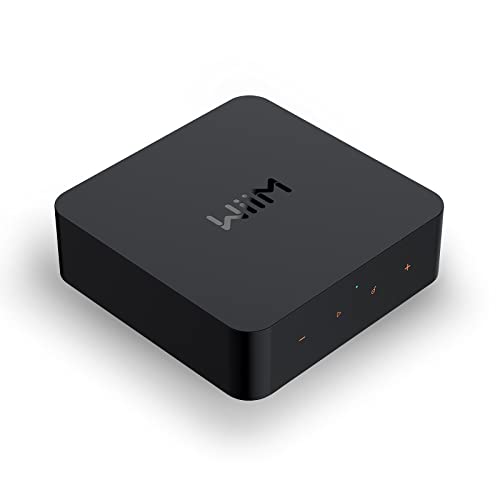
Transform your stereo into an AirPlay 2-enabled speaker with the WiiM Pro, which allows you to stream your favorite music from iOS and Mac devices. Not just that, you can also stream TV audio from Apple TV. With Chromecast, you can stream music, TV audio, radio stations, podcasts, and local content from hundreds of Chromecast-enabled apps to one or multiple audio devices simultaneously. The WiiM Pro offers gapless playback of Hi-Res 192 kHz, 24-bit music wirelessly on its digital and analog output. It supports Amazon Music Ultra HD, Qobuz, and your own music library to provide bit-perfect output via its digital optical or Coax output. However, it is important to note that not every music service offers 24-bit/192 kHz music content. For instance, TIDAL Master is supported with the MQA core decoder up to 24-bit/96kHz for TIDAL Connect. The WiiM Pro also supports Spotify Connect, TIDAL Connect, and Amazon Music Casting. You can stream music directly from the Spotify, TIDAL, or Amazon Music app using Spotify Connect, TIDAL Connect, or Alexa. The WiiM Pro offers higher audio quality and longer work range than traditional Bluetooth or AirPlay 2 receivers, liberating your mobile device for other tasks. It works for Spotify Free/Premium users, TIDAL's HiFi and Master quality (with MQA), Amazon Prime Music, and unlimited. The WiiM Pro is compatible with Alexa, Google Voice, and Siri voice assistants, so you can use your voice in your phone, HomePod, Echo, or Google Home to control music selection, volume, and playback. The WiiM Pro allows you to stream music throughout your home via almost every smart speaker, including Apple AirPlay 2, Google Chromecast, Amazon Alexa, or our own multiroom function. You can group it with other AirPlay 2, Google Home, Alexa devices, such as Echo, HomePod, or multiple WiiM devices, and play to multiple audio devices all at the same time. However, it is important to note that the WiiM Pro does not support the transmission of the SPDIF-in or Line-In audio to AirPlay 2 or Echo devices, and it cannot group with other Sonos speakers in the Sonos App.
- Transforms your stereo into an AirPlay 2-enabled speaker
- Streams music, TV audio, radio stations, podcasts, and local content from hundreds of Chromecast-enabled apps
- Offers gapless playback of Hi-Res 192 kHz, 24-bit music wirelessly
- Provides bit-perfect output via its digital optical or Coax output
- Supports Amazon Music Ultra HD, Qobuz, and your own music library
- Supports Spotify Connect, TIDAL Connect, and Amazon Music Casting
- Compatible with Alexa, Google Voice, and Siri voice assistants
- Allows you to stream music throughout your home via almost every smart speaker
- Allows grouping with other AirPlay 2, Google Home, Alexa devices, such as Echo, HomePod, or multiple WiiM devices
- – Does not support the transmission of the SPDIF-in or Line-In audio to AirPlay 2 or Echo devices
- – Cannot group with other Sonos speakers in the Sonos App
9. Acemax Wifi Music Receiver: Convert Wired Speakers!

Experience crystal clear lossless sound throughout your home with the Acemax Audio Receiver. This device allows you to control individual or combined playlists and streaming services for multiple speakers directly from your iOS or Android app.
You can link multiple speakers by room or control them separately using your Android or iOS portable devices to set up speaker groups and control what plays in each room. Enjoy your own music via WiFi or Bluetooth, as well as great streaming services and internet radio such as Spotify, Tidal, Tune In, and iHeart Radio.
Please note that the Acemax Audio Receiver does not support Pandora, YouTube Music, Google Play Music, or Airplay 2. However, Airplay is compatible with iPhone 6S or higher, and iOS 14.4.2 or higher is required. To connect Airplay, make sure the Acemax Audio Receiver and your mobile device are both connected to the same WiFi network.
In addition, you can add your current stereo to your WiFi sound system by connecting it to the aux in via a 3.5mm or optical cable. The Acemax Audio Receiver also comes with an IR remote control for added convenience.
- Crystal clear lossless sound quality throughout your home
- Control individual or combined playlists and streaming services for multiple speakers from your iOS or Android app
- Link multiple speakers by room or control them separately using your Android or iOS portable devices
- Enjoy your own music via WiFi or Bluetooth, as well as great streaming services and internet radio such as Spotify, Tidal, Tune In, and iHeart Radio
- Add your current stereo to your WiFi sound system by connecting it to the aux in via a 3.5mm or optical cable
- Comes with an IR remote control for added convenience
- – Does not support Pandora, YouTube Music, Google Play Music, or Airplay 2
10. Linkup Wifi Speaker Adapter – True Wireless Sound
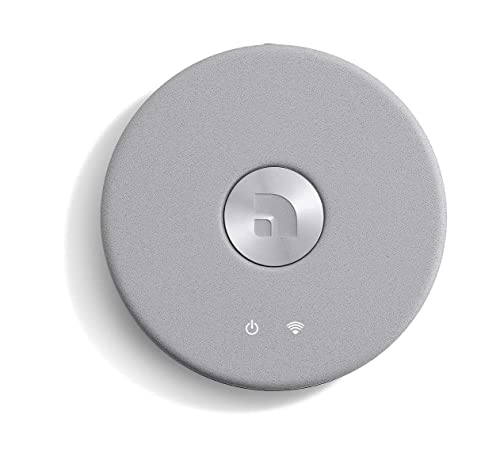
The Audio Pro LINK 1 is a handy device that allows you to turn any old stereo or turntable into a WiFi multiroom speaker, without the need for an expensive upgrade. You can enjoy wireless streaming from your favorite music streaming apps by simply plugging in the Link 1 to your audio system.
This compact home stereo receiver is compatible with any speaker or home stereo system that does not have wireless capabilities. You can easily connect through 2.4 GHz WiFi or an Ethernet cable and use a TOSlink Optical or 3.5mm aux cable from the LINK 1 to your old speaker. It's a perfect combo of convenience and efficiency.
The Audio Pro LINK 1 comes with an efficient Audio Pro App that makes it easy to control your music through your phone or tablet, and even easier with saved presets. It provides a convenient pairing with other Audio Pro WiFi (C-series) speakers to stream music throughout your home. LINK 1 is the perfect accessory for your home stereo system.
- Turns any old stereo or turntable into a WiFi multiroom speaker
- Compatible with any speaker or home stereo system that does not have wireless capabilities
- Efficient Audio Pro App makes it easy to control your music through your phone or tablet
- You can connect through 2.4 GHz WiFi or through an Ethernet cable and use a TOSlink Optical or 3.5mm aux cable
- Convenient pairing with other Audio Pro WiFi (C-series) speakers to stream music throughout your home
Best Wifi Audio Receiver Adapter FAQs
Can a wifi audio receiver adapter be used with any type of audio device?
Yes, a WiFi audio receiver adapter can be used with any type of audio device as long as it has an audio input or output port. WiFi audio receiver adapters are designed to convert traditional audio devices into wireless-enabled ones, allowing users to stream music or audio wirelessly from their smartphones, tablets, or laptops. These adapters usually come with multiple connectivity options such as Bluetooth, WiFi, and NFC, enabling users to connect to a wide range of devices. Some WiFi audio receiver adapters also support multi-room audio, allowing users to stream music simultaneously to different rooms or speakers. However, it is important to ensure that the adapter is compatible with the audio device and that the audio quality is not compromised during the wireless transmission. Overall, a WiFi audio receiver adapter is a versatile and convenient solution for anyone looking to upgrade their audio setup without having to replace their existing devices.
How do I set up and connect a wifi audio receiver adapter to my home audio system?
Setting up and connecting a wifi audio receiver adapter to your home audio system is a fairly simple process that requires minimal technical expertise. To begin with, you need to select a wifi audio receiver adapter that is compatible with your home audio system. Once you have ensured compatibility, connect the adapter to your home audio system using the appropriate cables. Next, you need to download and install the relevant app that comes with the adapter on your smartphone or tablet. Follow the instructions provided in the app to configure the adapter and connect it to your home wifi network. Once the adapter is connected to your home wifi network, you can use the app to stream music from your smartphone or tablet to your home audio system wirelessly. You can also use other compatible devices such as laptops or desktops to stream music to your home audio system via the wifi audio receiver adapter. With these simple steps, you can enjoy high-quality wireless audio streaming in your home.
What are the benefits of using a wifi audio receiver adapter over traditional wired audio connections?
There are several benefits of using a wifi audio receiver adapter over traditional wired audio connections. Firstly, a wifi audio receiver adapter allows for greater flexibility in terms of placement and mobility. Unlike traditional wired connections, which require physical cables and connections, a wifi audio receiver adapter can be placed anywhere within the range of the wifi network, and can easily be moved around as needed. This makes it ideal for situations where mobility is important, such as in a home theater or outdoor entertainment area.
Secondly, a wifi audio receiver adapter often has better sound quality than traditional wired connections. This is because wifi connections are typically more stable and reliable than wired connections, resulting in less interference and better overall sound quality.
Finally, a wifi audio receiver adapter is often more affordable than traditional wired connections, as it requires less hardware and installation costs. This makes it ideal for those on a budget who still want high-quality audio in their home or entertainment space.
Overall, a wifi audio receiver adapter offers a range of benefits over traditional wired audio connections, including greater flexibility, better sound quality, and affordability.
What features should I look for in a wifi audio receiver adapter?
When looking for a WiFi audio receiver adapter, there are several features that you should consider. Firstly, ensure that the adapter supports the audio format you need, such as AAC, MP3, or FLAC. Secondly, check for the availability of multiple connectivity options, including Bluetooth, WiFi, and NFC. This will help you connect the adapter with a wide range of devices, such as smartphones, tablets, laptops, and audio systems. Additionally, consider the range of the adapter, which determines how far it can transmit audio signals. A good WiFi audio receiver adapter should have a range of at least 30 feet. Another important factor to consider is the audio quality, which is determined by the sampling rate, bit depth, and frequency response. Look for an adapter with a high sampling rate, bit depth, and frequency response for superior audio quality. Finally, check for additional features such as voice control, multi-room audio, and compatibility with popular music streaming services. With these features in mind, you can choose the best WiFi audio receiver adapter that meets your needs and budget.
What is a wifi audio receiver adapter and how does it work?
A wifi audio receiver adapter is a device that allows you to stream audio from your phone, tablet or computer to your home audio system wirelessly. It works by connecting to your home wifi network and receiving audio signals from your device over the network. Once the device receives the audio signal, it converts it into an analog signal that can be played through your home audio system.
To use a wifi audio receiver adapter, you need to connect it to your home audio system using a standard audio cable or through bluetooth. After that, you need to connect the adapter to your home wifi network by configuring it through a mobile app or web interface. Once the adapter is connected to your wifi network, you can start streaming audio from your phone, tablet or computer to your home audio system wirelessly.
A wifi audio receiver adapter is a great way to enjoy high-quality audio without the need for messy wires and cables. It is also a convenient way to stream audio from multiple devices to your home audio system. Whether you're listening to music, watching movies or playing games, a wifi audio receiver adapter can enhance your audio experience and make it more immersive.

